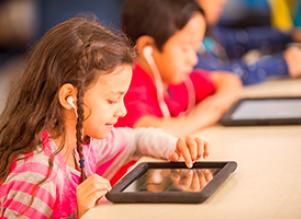7/15/2020
Putting Social and Emotional Learning to Work: Implementation Strategies and Tips
Will a student skilled at self-regulation be better equipped to learn? The answer, according to the theory of social and emotional learning (SEL), is yes.
Although some observers have pegged SEL as little more than a buzzword that's easy to throw around but tough to define and implement, the idea has steadily gained traction in K–12 education over recent years.
A 2019 EdSurge post offered some context for SEL's rise in prominence: The increased role of technology in kids’ lives has made it harder to keep the stresses and distractions of the outside world away from the classroom. According to EdSurge's Emily Tate, this phenomenon has compelled educators to recognize that “in order for kids to be successful academically, their other needs must be met, too”—and that's where SEL comes in.
That said, SEL is much more than a strategy to employ only when students are having a hard time focusing. In a blog post for Edutopia, Roger Weissberg, a lead administrator with the Chicago-based Collaborative for Academic, Social, and Emotional Learning (CASEL), took a broader look at the value of taking a more holistic approach to education.
According to Weissberg, today's teachers typically encounter students from many walks of life, and using a tool like SEL can help them build connections and community in their classrooms. Moreover, research has shown that students who possess self-awareness and self-regulation—two key goals of most social-emotional lessons—are more able to weather challenges while staying focused and connected to others.
The evidence in favor of SEL can seemingly be found everywhere, from blog posts to education journals. For educators looking to implement the approach sooner rather than later, here are some ideas for how to bring SEL into the classroom.
Be inclusive
In a 2010 Edutopia post, professors Scott Seider and Daren Graves contended that social-emotional strategies should be “enacted in ways that are culturally responsive to and equitable for youth from historically marginalized groups.” The pair went on to recommend that educators use lessons that encourage greater self-awareness, reflection, and relationship skills to tackle tough topics such as historical trauma and oppression.
Although Seider and Graves noted that tenacity or "grit" is frequently pointed to as a key ingredient for success in and out of school, they also drew attention to its limitations. According to the duo, it is important for educators to acknowledge that students' "ability to thrive" is often connected to external factors.
Encourage lifelong learning
A social-emotional curriculum has the potential to serve students for a lifetime. In a 2019 article about SEL being implemented within Rochester, Minnesota's public schools, reporter John Molseed noted that being able to manage one's emotions is an important aspect of professional success, yet “many students are struggling with developing emotional skills that are essential for people entering the workforce.”
Indeed, as Rochester elementary school teacher Megan Hansen told Molseed, the ability to self-regulate and get along with others can mean the difference between keeping and losing a job. According to Hansen, emphasizing positive behavior traits such as patience and cooperation has proven to be an essential foundation for everything she tries to teach her students.
Hansen's approach centers on introducing a lesson that “usually involves understanding or identifying emotions and responses to them,” Molseed reported. She then reinforces this lesson throughout the week while conducting frequent mini-assessments that gauge students' thoughts, feelings, and awareness of their emotions and behaviors.
Ultimately, the combination of repetition, frequent exposure, and opportunities to put new skills and ideas into practice has helped make SEL lessons stick.
Proceed with intention
According to the information-rich CASEL website, “The most effective SEL requires a strategic, systemic approach that involves everyone, from district and school leaders to community partners to family members, working together to ensure students receive the support they need.”
In other words, SEL shouldn't be reduced to a buzzword or an item on a teacher’s to-do list. To implement SEL optimally and appropriately, CASEL advises a comprehensive approach that is similar to the purpose of SEL itself: creating safe, positive, and productive places for students to shine at home, at school, and beyond.


